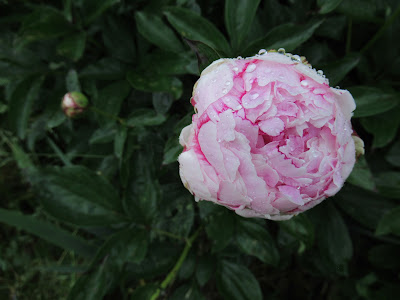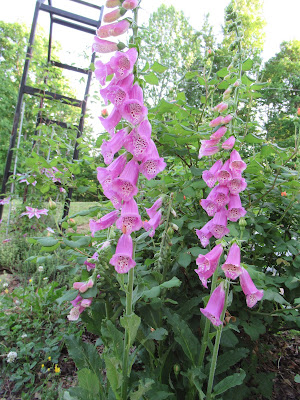Clematis Duchess of Edinburgh had a rough start to the season; mid-April frosts as she emerged from dormancy; a dose of cold rain and hail during the first weekend of May. I trimmed off blighted leaves and stems; the reward has been two blossoms. I hope for a reblooming in early September.
Samaritan Jo has a semi-dwarf mounding habit and was easier to cover during the April frosts.
Edita, also a low growing variety has entwined with Samaritan Jo.
Dr. Ruppel, planted in 2021, is the closest I could find to the heritage variety Nellie Moser. Several of the latest blooms have a deeper magenta hue than usual.
Here is the contrast between earlier and later blooms--both are more vivid than Nellie Moser.
Arabella--a struggling small clematis reaching for the wonky fence.
Clematis Jackmanni--the last of my collection to bloom.
It is considered hardy to Ag. zone 4--my Vermont garden was borderline for zone 4 plants and I never ventured a clematis.
From wikipedia: Clematis 'Jackmanii' is a Clematis cultivar which, when it was introduced in 1862, was the first of the modern large-flowered hybrid clematises of gardens. It is a climber with large violet-purple blooms, still among the most familiar climbers seen in gardens. It was produced from crosses made by the prominent nurseryman George Jackman (1837–1887),[1] of Jackman & Sons, Woking, Surrey.
White flowered clematis, the only survivor of the bargain assortment ordered three years ago from Spring Valley nursery. The tiny plants, mere 'slips' were indifferently packaged with labels that fell out of the shipping box when I removed the plants. I appreciate the delicate shading that enhances white flowers.
When we moved into our first Kentucky property in 2010 I was delighted to find two clematis, 'Candida' and 'Nellie Moser' starting their spring climb up a trellis improvised from chicken wire and stakes. During the years we lived there an elegant trellis was provided by son-in-law Matt, which encouraged new growth. Nellie Moser clambered into an adjacent nandina shrub.
Neither clematis was in bloom when we moved from that property in October, 2014. I hastily dug some small roots, hoping I had some of each heritage plant, but only 'Candida' made the move.
Single white peony before rain.
Very little definition in this photo as I wanted a view of the peony group.
Familiar raspberry red peony, probably Karl Rosenfeld.
This vintage peony was a mainstay in the dooryards of old farmsteads and village houses in my native New England, often in company with white Maxima. We didn't call them by 'names'--a root of 'red' or 'white' might be shared with a special friend or neighbor.
This double white was purchased several years ago and moved to our present location in the fall of 2018. It doesn't have the slender pink anthers [?] which distinguish Maxima.
No name tag on this favorite single white--offerings at big box garden centers are often an assortment.
Sarah Bernhardt, a familiar vintage pink.
The burst of hail mid-morning of May 7th, sliced off the tips of foxglove, shredded clematis blooms, pummeled the beet and lettuce seedlings in the raised planting boxes.
Decapitated foxglove still blooms.
This is one of my most prolific foxgloves. It produces 'babies' each season which I collect and pot on.
The foxglove that appears cream/yellow in bud opens to a pale lavender pink.
I think I have three distinct varieties in this wall planting. Sutton's Apricot and a white flowering variety didn't reappear after the second year, nor can I distinguish any that might be from the Camelot plants. I will take foxglove in any coloration they care to perpetuate, and have allowed them to grow in close proximity to the David Austin roses if they so choose.
David Austin "Queen of Sweden'--a very upright rose bush.
Beautiful in all phases.
David Austin "Roald Dahl"--sprawling with lax habit, blooms early and late.
Roald Dahl
As the blossoms fade they take on a creamy pinkish hue with darker pink freckles.
David Austin, 'The Poet's Wife'
The Poet's Wife
The season of roses is brief here in south-central Kentucky. Frost always hits the plants as they begin to break dormancy; I can plan on pruning twice before the shrubs are in full vigorous leaf. Perhaps three weeks or at best four in exuberant bloom before hot and humid weather invites Japanese beetles and sawfly larvae.
A vase of blooms is pretty for a day or two then walking past I hear the whisper of falling petals.
I take endless photos each year--cherishing the brevity of beauty.


























Beautiful flowers!
ReplyDeleteA: Flowers are a joy!
DeleteWow, how beautiful your flowers are! You certainly have a wonderful collection of clematis vines. I am impressed at how well you know all their names. And, I love love your header picture!
ReplyDeleteMary; I try to remember the names of the clematis and the roses if nothing else--tags disappear and unless I've made a record on my blog or in a saved notebook, I forget. My favorite clematis is the early flowering Candida--which always rushes into bud before the weather has settled. The header photo of the moment is 'Queen of Sweden' a David Austin rose.
Delete